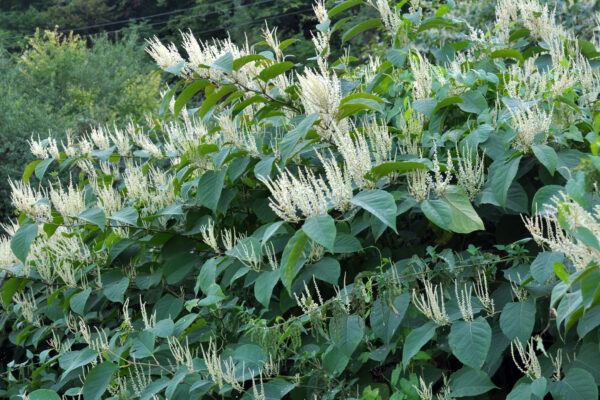
Japanese Knotweed
Japanese Knotweed (Fallopia japonica) is a shrub-like perennial plant that spreads quickly, degrades habitats, displaces native plants by forming dense colonies, and is difficult to eradicate. It is sometimes referred to as “Elephant Ear Bamboo” because it has bamboo-like stems and large heart-shaped leaves that resemble an elephant’s ear.
Species Description
Japanese Knotweed is an upright, shrub-like perennial plant that can grow to heights of over 13 ft (4 m). The leaves are wide, with a heart-shaped base that narrows to a point at the tip. Stems are smooth and hollow, resembling Bamboo, especially in older plants. Flowers are small and arranged in white clusters that appear in late summer to early fall. Dead stems can survive throughout the winter, with new shoots forming dense thickets in the spring. The dead stems and leaf litter decompose very slowly, forming a deep litter layer that prevents native seeds from germinating.
Native & Introduced Ranges
Native to Japan, China, and parts of Korea and Taiwan, Japanese Knotweed was introduced to North America in the late 1800s as an ornamental plant, where it was sold in nursery catalogs throughout the United States. Subsequent introductions of Japanese Knotweed occurred for erosion control and landscape screening. It can now be found throughout the eastern United States, in several western states, and is widespread throughout Pennsylvania.
Biology & Spread
Japanese Knotweed primarily spreads via rhizomes, which are long, thick, underground stems that branch out to start new infestations. Once established, they rapidly form dense colonies, displacing native plants. Japanese knotweed can be spread when rhizome fragments move to new areas through water currents and wind. It can also be transported to new sites in contaminated soil, as escapees from neglected gardens, or as discarded cuttings. While Japanese Knotweed can produce seeds, germination is rare and therefore this species typically does not spread through seed dispersion.
Habitat
Japanese Knotweed is tolerant of a variety of growing conditions, including full shade, high temperatures, high salinity, drought, and flooding. It commonly grows in damp soil along streams and rivers, in wetlands, in disturbed areas, along roadways, and around old home sites. Impacts
Threat to Biodiversity
Japanese Knotweed is an aggressive species that emerges early in the spring and grows rapidly to form dense, monotypic stands that displace native plants and degrade habitats for both plants and animals. It poses a significant threat to riparian areas, where it can survive severe floods and rapidly colonize scoured shores and islands. Furthermore, by displacing native grasses and plants that help anchor soil, Japanese Knotweed leaves streambanks more vulnerable to erosion during floods, worsening sedimentation problems.
Prevention & Control
Once established, populations of Japanese Knotweed are extremely persistent and difficult to remove. Manual control may consist of digging out the rhizomes or cutting the stalks; however, digging is very labor intensive and can promote further invasion by spreading the rhizome fragments. Successful eradication is not likely with cutting alone; it may require a combination of cutting and applying herbicides. Regardless of which control method is used, if some viable rhizomes remain in the soil, Japanese Knotweed will return once management is relaxed.



